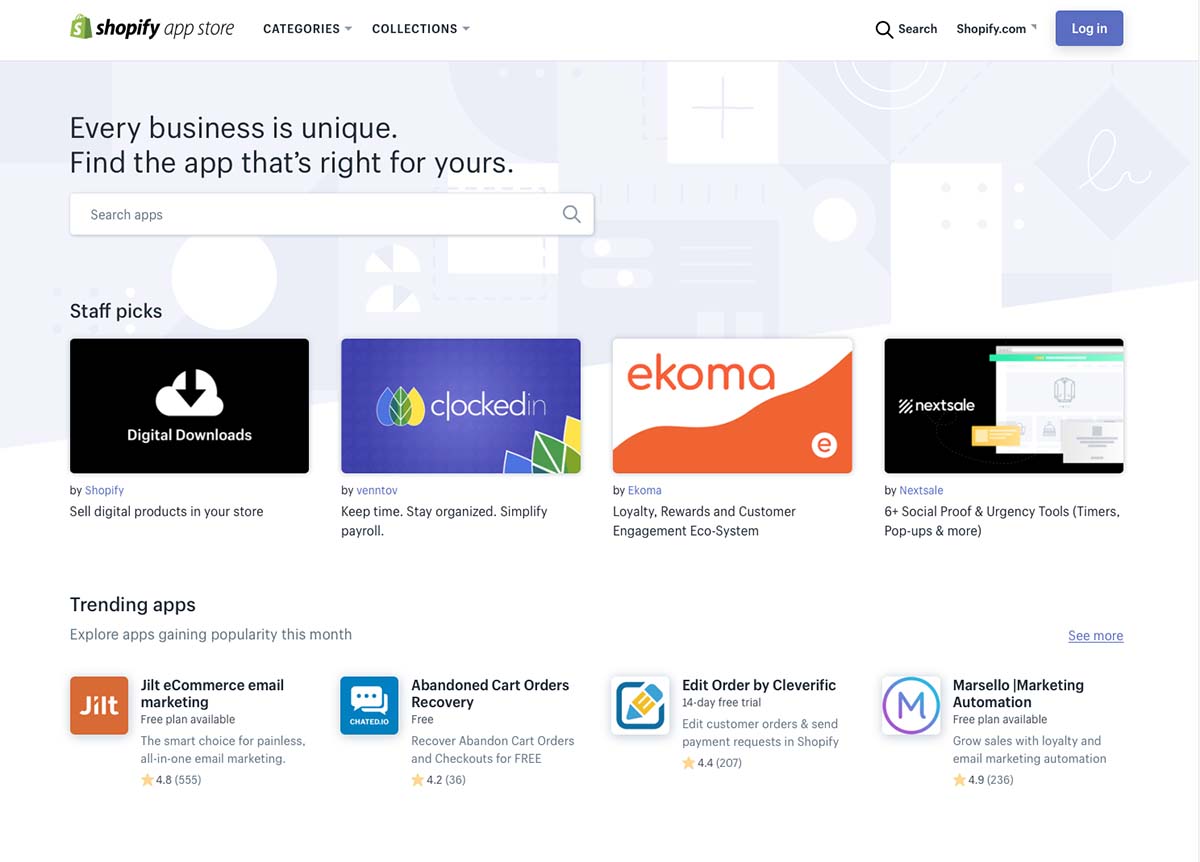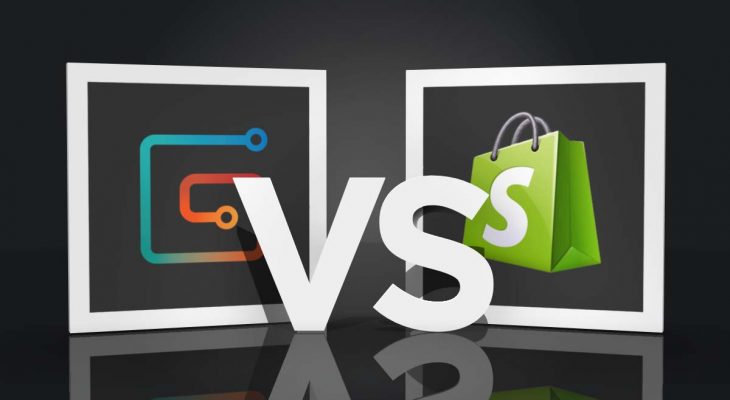When it comes to selling digital products online, my two most favorite platforms for doing so are Gumroad and Shopify. Both are incredibly easy to set up and maintain, which is really important for me as a content creator because it allows me to focus on nothing else but creating great digital products.
I never have to fumble around trying to get software working correctly, which is incredibly important. However, the question remains: when it comes down to Gumroad vs Shopify, which one is better?
The easy answer to that is simple: I much prefer Shopify. This is mostly because of the vast array of marketing and administrative tools available (for free) to each merchant, and I feel like it gives me the power to grow as big as I want.
In comparison, Gumroad feels more like a growing start up company that hasn’t quite reached maturity. It’s about as basic as you can get for selling products online, which is great for beginners. However, those needing more powerful customer management tools and invoicing capabilities will need the extra power that comes with even the most basic Shopify plan.
In the interest of full disclosure, I need to re-iterate that I’ve been using both of these products for years now and I am generally happy with both. Therefore, I feel that I am fully qualified to put together this impartial Gumroad vs Shopify review which can help you decide which one is best for your specific needs.
| Gumroad | Shopify | |
|---|---|---|
| Sell digital products (PDFs, videos, images, courses, audio files, etc) |  |  |
| Sell physical products |  |  |
| Sell items directly from your blog |  |  |
| Offer subscription plans to your customers |  |  |
| Fully functional e-commerce website with themes and customization options |  |  |
| Pricing | $10/mo | Starting at $29/mo |
Things you can do with Shopify that you cannot to do with Gumroad
The best part about Shopify is the fact that it was built from the ground up to be the most powerful and easy to use e-commerce platform of them all. It seems no expense was spared to hire the best team of designers and engineers to put together this amazingly useful web tool.
And to be quite honest, I almost feel like it’s not even fair to do a Gumroad vs Shopify comparison. Shopify is just so much better in so many other ways, and the only way to explain that is to jump right in and tell you exactly what I mean:
The Shopify store front
The biggest and best difference that Shopify has over Gumroad is the fact that it allows you to create a beautiful website that’s all your own in just minutes. And when it comes right down to it, the shopping experience is the most important thing when it comes to e-commerce.
If your buyers can’t find what they’re looking for or they don’t have a pleasant experience browsing your online store, then what’s the point? A clean and polished website is one of the best ways to establish credibility online, and you’ll get that instantly with Shopify.
Yes, Gumroad does give you the ability to create an online marketplace to sell your digital products, but they do it in a slightly different way. I’ll get into later in this post.
All you really need to know when it comes to a Gumroad vs Shopify comparison is the fact that you’ll get a beautiful website with Shopify but you won’t with Gumroad. If that’s important to you (and it should be), Shopify is the way to go.
Back end administrative tools for customer and product management
When I set up my first Shopify store in late 2015, I was blown away by the powerful administrative tools that came with the platform. My digital product catalog consists of 150 unique items, so it’s very important to me to have the tools I need to manage them all in a way that doesn’t make me want to pull all of my remaining hair out.
For example, the ability to batch edit things like prices and file names has saved me hundreds of hours over the years. At the time of this writing, batch editing is not yet possible with Gumroad.
I also really appreciate the way Shopify organizes my customers and their orders for me. It’s all very neat and organized, which makes the arduous task of creating invoices when necessary a much easier thing to do. Gumroad vs Shopify is a no brainer in regards to the tedious administrative stuff.
Using the power of the Shopify app store to create a powerful e-commerce business
One of the best things about Shopify is the fact that there is a very large and active app store behind it. This is important because if you’re serious about building a massive e-commerce business (and not just a little website to sell your digital products), you’re going to need to deal with things like email marketing and advertising campaigns.
Thanks to the Shopify app store, it’s incredibly easy to add extra functionality to your website with just a few clicks and a small fee.
I don’t know about you, but having the ability to build exactly the e-commerce business that I want with only the tools I need is a pretty big deal. It’s also a massive timesaver and it allows me to focus on doing what I do best: creating great digital products.

The Gumroad approach to expansion and integration of things like email marketing and advertising campaigns is more of a “do it yourself” (DIY) kind of thing. They don’t offer much help or assistance when it comes to building out your business, so just know that you’re going to be on your own going with Gumroad.
Things you can do with Gumroad that you cannot do with Shopify
If you’ve made it this far, it wouldn’t surprise me a bit if you’re starting to think that I’m not a fan of Gumroad. That’s not the case at all, because the truth is that I’ve been a very happy Gumroad subscriber for over two years now and I have no plans of canceling.
However, this is supposed to be an impartial Gumroad vs Shopify review, so it has to be expected that I’m going to be a little bit negative here and there. As a matter of fact, it’s now time to turn the tables a bit and talk about all the things that Gumroad does better than Shopify.
The ability to embed digital products on an external website or blog
The ability to allow my customers to purchase my digital products directly on my website without having to click away is what attracted me to Gumroad in the first place. And as far as I’m concerned, there is no better product for this kind of feature.
Yes, you can embed digital products into your website with the Shopify “buy button”, but it’s nowhere near as seamless of an experience as the way Gumroad does it.
Remember that Shopify was built from the ground up to allow people to create their own online marketplace from scratch. However, Gumroad takes a slightly different approach by offering a powerful tool for people with existing websites or blogs to easily embed and sell their digital products without the need for a dedicated store.
Gumroad easily wins this portion of the Gumroad vs Shopify battle royale.
Gumroad is cheaper
I suspect that for many people, keeping costs down is the highest priority. At the time of this writing, a subscription to Gumroad costs just $10 a month. As part of that subscription, you have the ability to sell an unlimited number of digital products to an unlimited number of customers. It’s a pretty good deal if you ask me.
In comparison, the most basic Shopify plan cost $29 a month. This is pretty steep if you’re just starting out and don’t yet have a loyal customer base, so keep that in mind if you’re just starting with e-commerce.
One of the things I suggest to most people just getting started with selling digital products online is to start with Gumroad to get a feel for things, and then switch over to Shopify when the business starts showing signs of growth. It’s much easier to grow with Shopify that it is with Gumroad.
Fact: It’s easier to make money with Shopify than it is with Gumroad
In terms of the amount of money that you can make selling digital products online with Gumroad vs Shopify, my personal opinion is that it’s easier with Shopify (read how I’m currently making over $1000 selling digital products on Shopify).
The primary reason for this is because Shopify gives you a clean and polished website to sell your products, which to most people, feels more trustworthy then an embedded buy button on a blog (the way Gumroad does it).
Yes, having the ability to sell your digital products directly on your own blog (or anywhere else online like a social media feed) is extremely convenient for the buyer. However, keep in mind that many people will feel a slight bit of hesitation before entering their credit card information into a pop up window or integrated web form on a sketchy-looking blog.
As a matter of fact, I’ve noticed this hesitation trying to sell the same digital product with Gumroad vs Shopify. I’ve done it with several digital products actually, and every time, I get 50% more sales on my Shopify store then I do with selling the product directly on my blog via Gumroad. Both the blog and the Shopify store get the same amount of daily traffic, so my only conclusion is that people feel that the Shopify store looks and feels more trustworthy than my rinky-dink WordPress blog.
Why would you choose Gumroad vs Shopify?
Even though I’ve mentioned several times in this article already that I much prefer Shopify for selling my digital products, that’s not to say that Gumroad isn’t worth considering.
The really nice thing about the Gumroad approach to selling digital products is that it’s designed to be simple. Creating an intuitive and easy to use shopping cart system is the entire core of their existence, and I’m here to tell you that they’ve succeeded in their mission. Selling digital products via Gumroad is incredibly easy.
If all you have is one or two digital products and an existing blog or a website to promote them with, I fully recommend going with Gumroad.
However, I would strongly recommend keeping Shopify in mind as the e-commerce platform that you need to move to as your business grows. Gumroad is a great way to get started selling digital products online, but Shopify is the tool you need to turn it into a thriving business.
How I use Gumroad vs Shopify
Now that I’ve explained all the ways that Gumroad is different than Shopify, I’d like to spend a moment to put it all together and tell you how I use both in my business.
To sum it up in the best way possible, Gumroad vs Shopify was never a question I personally struggled with. There are pros and cons to each, and as diverse as my online businesses are, it’s been very easy to make both work for me in a way that I am very satisfied with.
I use Shopify to sell my premium collection of digital products with the Digital Downloads app, which consists of roughly 150 items (and growing). These are moderately priced digital products in the $40-$50 range, and I market them as being very premium items for businesses (not individuals).
Since they are all related to one another, I feel it’s important to have a dedicated website for that collection. Shopify makes it very easy to do that. And as I mentioned earlier, having a clean and professional looking website is important for me to establish credibility with my corporate clients.
On the flip side, I use Gumroad for selling one-off digital products that aren’t necessarily tied to any other digital product that I’m selling. A perfect example of this is an e-book or detailed checklist I offer as a bonus for an existing blog post. (You can see how I embed a link to buy my ebook in my post about what I learned while writing my first book).
Gumroad makes that very easy since at the very end of the blog post, I can write a short paragraph which introduces the digital products I’m trying to sell, followed by an embedded by button immediately thereafter.
The idea of creating a blog post which answers someone’s question, followed up by a link to buy an e-book or highly detailed worksheet (which will help the reader even more) is something that has been working well for me. Gumroad helps me do that.
Conclusion
When it comes to Gumroad vs Shopify for selling your digital products and creating an engaged customer base, it all boils down to personal needs.
I’d actually recommend starting with both, as that’s usually the best way to figure out what you want and don’t want in an e-commerce solution. Unfortunately, Gumroad doesn’t offer a free trial, but Shopify does. Therefore, it’s only going to cost you $10 (the cost of 1 month of Gumroad) to trial both for 30 days. And if you’re serious about selling digital products online, you’d be a fool not to dive in head first and put both to the test to see which one is right for you.
Get your free 14-day free Shopify trial here, and sign up for Gumroad by clicking here.





